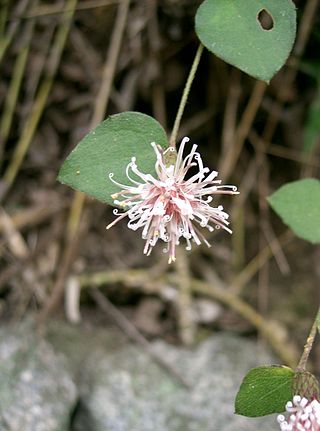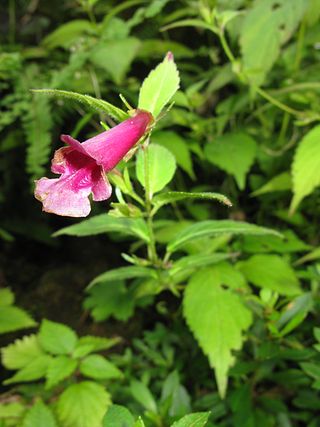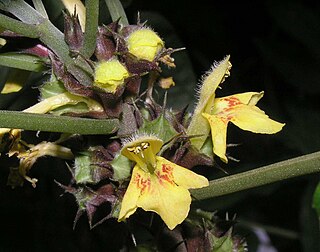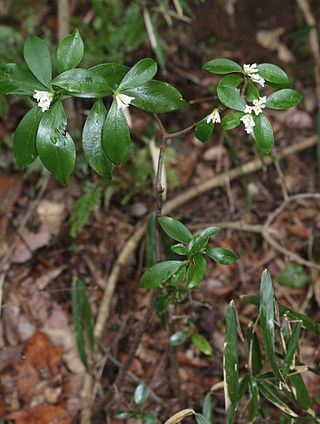
Adenophora is a genus of flowering plants in the family Campanulaceae, the bellflowers. Plants of this genus are known commonly as ladybells. Most of the species in the genus are native to eastern Asia, with a few in Europe. Many are endemic to either China or Siberia.

Osmanthus is a genus of about 30 species of flowering plants in the family Oleaceae. Most of the species are native to eastern Asia with a few species from the Caucasus, New Caledonia, and Sumatra. Osmanthus has been known in China since ancient times with the earliest writings coming from the Warring States period; the book Sea and Mountain. South Mountain states: "Zhaoyao Mountain had a lot of Osmanthus".

Triadica is a plant genus of the family Euphorbiaceae first described as a genus in 1790. It is native to eastern southeastern, and southern Asia.

Croomia is a genus of primitive angiosperm herbs in the Stemonaceae family, first described as a genus in 1840.

Caryopteris is a genus of flowering plants in the family Lamiaceae. They are native to east Asia.

Cinnamomum tenuifolium, commonly known as Japanese cinnamon, is an evergreen tree in the genus Cinnamomum. It is a small- or medium-sized tree up to 15 m (49 ft) tall that occurs in Japan, Korea, Taiwan, and eastern China. In China it is under second-class national protection.

Collinsonia is a genus of flowering plants in the family Lamiaceae. It is native to East Asia and eastern North America. It was named for the English botanist Peter Collinson (1694–1768) by Carl Linnaeus in Species Plantarum in 1753. It is in the tribe Elsholtzieae, a small tribe of only 5 genera. In order of their number of species, they are Elsholtzia, Mosla, Collinsonia, Perilla, and Perillula.
Phaenosperma is a genus of Asian plants in the grass family. The only known species is Phaenosperma globosum, native to China, Japan, Korea, Assam, and Bhutan.

Lophatherum is a genus of Asian and Australian plants in the grass family.

Pertya is a genus of Asian flowering plants in the family Asteraceae.

Dioscorea japonica, known as East Asian mountain yam, yamaimo, or Japanese mountain yam, is a type of yam (Dioscorea) native to Japan, Korea, China, Taiwan, and Assam.

Blyxa is a genus of an aquatic plant of the family Hydrocharitaceae described as a genus in 1806.

Callicarpa (beautyberry) is a genus of shrubs and small trees in the family Lamiaceae. They are native to east and southeast Asia, Australia, Madagascar, south-eastern North America and South America.

Chelonopsis is a genus of plants in the family Lamiaceae, first described in 1865. It is native to China, Japan, and the Western Himalayas.
Matsumurella is a genus of flowering plants in the family Lamiaceae, first described in 1915. It is native to China and Japan. The genus is closely related to Galeobdolon, and the species below are discussed under that name in Flora of China.
- Matsumurella chinensis(Benth.) Bendiksby - Anhui, Fujian, Guangdong, Guangxi, Hunan, Jiangsu, Jiangxi, Taiwan, Zhejiang
- Matsumurella kwangtungensis(C.Y.Wu) Bendiksby - Guangdong
- Matsumurella szechuanensis(C.Y.Wu) Bendiksby - Chongqing
- Matsumurella tuberifera(Makino) Makino - Japan, Ryukyu Islands, Taiwan, Guangxi, Hunan, Jiangxi
- Matsumurella yangsoensis(Y.Z.Sun) Bendiksby - Guangxi

Mosla is a genus of plants in the family Lamiaceae, first described as a genus in 1875. It is native to eastern Asia, the Himalayas, and southeastern Asia.
- Mosla bracteataDoan ex Suddee & A.J.Paton - Vietnam
- Mosla cavalerieiH.Lév.- Vietnam, Guangdong, Guangxi, Guizhou, Hubei, Jiangxi, Sichuan, Yunnan, Zhejiang
- Mosla chinensisMaxim. - Vietnam, Korea, Japan, Anhui, Fujian, Guangdong, Guangxi, Guizhou, Hubei, Hunan, Jiangsu, Jiangxi, Shandong, Sichuan, Taiwan, Zhejiang
- Mosla coreanaH.Lév. - Korea
- Mosla dianthera(Buch.-Ham. ex Roxb.) Maxim. - China, Japan, Korea, Ryukyu Islands, Kuril Islands, Primorye, Caucasus, Himalayas, Myanmar, Vietnam, Philippines, Sumatra
- Mosla exfoliata(C.Y.Wu) C.Y.Wu & H.W.Li - Sichuan
- Mosla hangchouensisMatsuda - Zhejiang
- Mosla japonica(Benth. ex Oliv.) Maxim. - Japan, Korea, Ryukyu Islands
- Mosla longibracteata(C.Y.Wu & S.J.Hsuan) C.Y.Wu & H.W.Li - Guangxi, Zhejiang
- Mosla longispica(C.Y.Wu) C.Y.Wu & H.W.Li - Jiangxi
- Mosla pauciflora(C.Y.Wu) C.Y.Wu & H.W.Li - Guizhou, Hubei, Sichuan
- Mosla punctulataNakai - Korea, Taiwan, Japan, China
- Mosla scabra(Thunb.) C.Y.Wu & H.W.Li - Vietnam, Korea, Japan, Ryukyu Islands, Anhui, Fujian, Gansu, Guangdong, Guangxi, Henan, Hubei, Hunan, Jiangsu, Jiangxi, Liaoning, Shaanxi, Sichuan, Taiwan, Zhejiang
- Mosla soochouensisMatsuda - Anhui, Jiangsu, Jiangxi, Zhejiang
- Mosla tamdaoensisPhuong - Vietnam

Paraphlomis is a genus of flowering plants in the mint family, Lamiaceae, first described in 1901. It is native to China, Himalayas, and Southeast Asia.

Lapsanastrum is a genus of flowering plants in the family Asteraceae, native to East Asia.

Vaccinium japonicum is a species of deciduous flowering shrub. They are native to Japan, Taiwan, Korea, and parts of China. They are specifically found in the provinces of Anhui, Fujian, Gansu, Guangdong, Guangxi, Guizhou, Hubei, Hunan, Jiangxi, Sichuan, Yunnan, and Zhejiang in China. They are typically found in forests and thickets within alpine areas between 1000 and 2600 metres. This species was once considered a subspecies of the North American species, Vaccinium erythrocarpum; however it has since been split to a full species.

Daphne kiusiana is a shrub of the family Thymelaeaceae. It is native to East Asia.


















